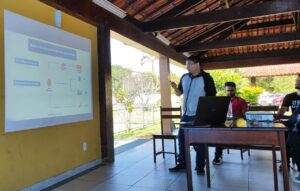Below the abstrast of João´s work
About 20 years ago, it was proposed that the NF-κB/Dorsal signaling pathway, which plays a fundamental role in the immune system of metazoans, had been co-opted from an ancestral role in immunity for the formation of the Dorsal-Ventral (DV) axis in insects. Understanding the evolution of the Gene Regulatory Network (GRN) involved in DV patterning in insects, even though they have pathways with highly conserved elements, is crucial for developmental biology. This is because modifications in its transcription factors and enhancers can dramatically alter its biological function. Notably, in contrast to what was seen in Drosophila melanogaster and other insects, basal branching arthropod groups, such as spiders, exclusively use the BMP/Dpp pathway to pattern the entire DV axis. Many studies have adopted traditional approaches, investigating orthologs of genes already known in D. melanogaster for comparative functional studies, using a strategy known as “the candidate gene approach. In this study, we employed an unbiased ChIP-Seq strategy to find cis-regulatory sequences (enhancers) targeted by NF-κB/Dorsal in the beetle Tribolium castaneum (Tc). Integrating Dorsal ChIP-seq data with FAIRE-seq data and transcriptomes from embryos with reduced expression (knockdown) of Toll, Twist, Sog, and Dpp enabled the proposal of a GRN in the DV patterning of this beetle. Our findings revealed 1,394 regions interacting with Dorsal in the T. castaneum genome, serving as potential cis-regulatory regions (CRM). The proximity of some of these regions to the genes twist, single-minded (sim), cactus, snail, and sog, known Dorsal targets in D. melanogaster, suggests the existence of conserved aspects in the GRN involved in DV patterning in holometabolous insects, particularly in genes expressed in the ventral region of embryos. Conversely, the composition of binding sites, sequence conservation, and relative positions of these enhancers related to genes in T. castaneum indicate divergent aspects between the studied GRNs. Also, unique modifications were found in the NF-κB /Dorsal binding motifs in T. castaneum, coupled with a considerable number of NF-κB/Dorsal bindings within tRNA genes, suggesting a potential regulatory mechanism for tRNA expression not yet observed in arthropods. In conclusion, this study provides, for the first time, a comprehensive comparative perspective on the zygotic DV axis GRN in insects.

João Paulo Vieira (PhD Student), Siegfried Roth (University of Cologne, Germany) and Jeremy Lynch (Univ. Illinois, Chicago, USA), Rodrigo Nunes-da-Fonseca (NUPEM-UFRJ-Macaé, Brazil).


